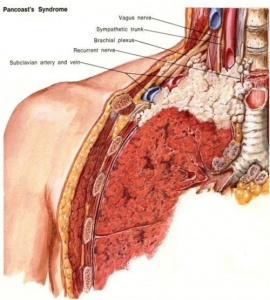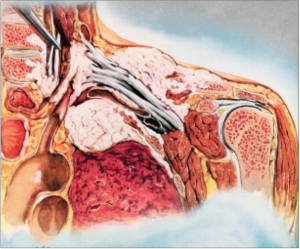Pancoast Tumor
Original Editors - Paul Clark & Sam Holzknecht from Bellarmine University's Pathophysiology of Complex Patient Problems project.
Lead Editors - Your name will be added here if you are a lead editor on this page. Read more.
Definition/Description[edit | edit source]
Pancoast tumor is an uncommon lung cancer that arises at the level of the superior sulcus and is limited to the apical segment of either lung. Cite error: Invalid <ref> tag; name cannot be a simple integer. Use a descriptive titleThis is a form of non-small-cell carcinomas (NSCLCs) that are very difficult to treat because of their proximity and frequent metastasis to adjactent structures such as the subclavian vessels, lymphatic system, brachial plexus, spine, second and third ribs, stellate ganglion, and the sympathetic nervous system. Cite error: Invalid <ref> tag; name cannot be a simple integer. Use a descriptive titleNSCLCs generally grow and spread slower and are divided into three different forms of cancer: squamous cell carcinomas (45-50%), adenocarcinomas (36-38%), or undifferentiated large-cell carcinomas (11-13%). Cite error: Invalid <ref> tag; name cannot be a simple integer. Use a descriptive titleRather than invading underlying lung tissue, this tumor presents as a abnormal patch of tissue over the lung apex and initially involves the chest wall strucutures. This can be treated if caught early on before it spreads and moves to the lymph nodes. Pancoast tumors are often mis-diagnosed and/or diagnosed too late.Cite error: Invalid <ref> tag; name cannot be a simple integer. Use a descriptive title
Tumor located at the apex of the lungs.
Pancoast tumors may occur in the three compartments of the thoracic inlet and symptoms are related to the location.
File:Pancoast tumor Anterior.png File:Pancoast tumor middle.png
File:Pancoast tumor posterior.png
Prevalence[edit | edit source]
"Lung cancers are the leading cause of death in both men and women in North American."Cite error: Invalid <ref> tag; name cannot be a simple integer. Use a descriptive title In 2011, there was an estimated new diagnosis of 221,130 new cases of lung cancer with 156,940 deaths relating to lung cancer. Lung cancer accounts for more deaths when compared to prostate/breast, colon, and pancreatic cancer combined.Cite error: Invalid <ref> tag; name cannot be a simple integer. Use a descriptive title Of the number of new lung cancer diagnosis, approximately 5% can be attributed to pancoast tumors.Cite error: Invalid <ref> tag; name cannot be a simple integer. Use a descriptive title The highest occurence is found in men between the ages of 40 and 60 with a history of smoking.
Characteristics/Clinical Presentation[edit | edit source]
Pancoast tumors are very difficult to diagnosis early on. This is based on their low prevalence rate and many differential diagnosis'. "Typical" symptoms of lung cancer such as cough, dyspnea, and haemoptysis are less frequent.Cite error: Invalid <ref> tag; name cannot be a simple integer. Use a descriptive title
Common presentations include:
referred pain over the scapula to the shoulderCite error: Invalid <ref> tag; name cannot be a simple integer. Use a descriptive title
pain is relieved by propping up arm on table or holding with other arm
radiating pain to the ulnar side of the arm and hand (55-60%)Cite error: Invalid <ref> tag; name cannot be a simple integer. Use a descriptive title
Horner's syndrome (30%)Cite error: Invalid <ref> tag; name cannot be a simple integer. Use a descriptive title
atrophy of the arm, forearm, and handCite error: Invalid <ref> tag; name cannot be a simple integer. Use a descriptive title
parasthesias of the handCite error: Invalid <ref> tag; name cannot be a simple integer. Use a descriptive title
between the ages of 40-60Cite error: Invalid <ref> tag; name cannot be a simple integer. Use a descriptive title
men > femaleCite error: Invalid <ref> tag; name cannot be a simple integer. Use a descriptive title
Associated Co-morbidities[edit | edit source]
muscle atrophy
cervical radiculopathy
Horner's Syndrome
COPD
vertebrae compression
bone cancer
Medications[edit | edit source]
Pharmacotherapy goals are to induce remission, reduce morbidity, and prevent complications [2]
Opioid Analgesics: Primary treatment of pain that can be combined with NSAIDs and may be a short-acting potent opioid such as oxycodone or an immediate-release morphine or methadone [1].
Antineoplastic agents: Inhibit cell growth and proliferation and are used in a variety of different cancers including head, neck, breast, testicular and ovarian cancer [2].
Cisplatin (Platinol): Alkylating agent causing intrastrand and interstrand cross-linking of DNA that leads to strand breakage. It has a broad range of antitumor activity and forms backbone of currently available approved combination chemotherapy regimens that cause Pancoast syndrome. Its administered via IV in isotonic sodium chloride solution (0.9%) or sodium chloride and glucose. Adequate hydration must be maintained up to 24 hours after a dose and Renal, hematological, auditory, and neurological function must be monitored [2].
Etoposide (Toposar, VePesid): Semisynthetic derivative of podophyllotoxin with antineoplastic properties interferes with topoisomerase II function thus inhibiting DNA synthesis [2].
Diagnostic Tests/Lab Tests/Lab Values[edit | edit source]
add text here
Etiology/Causes[edit | edit source]
Common risk factors include (similar to lung cancer):
smoking
secondhand smoke
asbestos exposure
exposure to industrial elements like gold or nickel
diesel exhaust
Systemic Involvement[edit | edit source]
Pancoast tumors are often mis-diagnosed or diagnosed too late to prevent metastasis to adjoining structures. This form of lung cancer is very dangerous because of its close proximity to other structures that include:
brachial plexus- this is commonly invaded at the ulnar distribution (C8-T1), thus atrohpy/parasthesia of the ulnar distribution is reported. This is often the patient's primary complaint/presentation to therapy with shoulder pain that radiates down to the 4th and 5th digit.
subclavian vessels- metastasis to the subclavian artery or adjoining structure may lead to deterioration or compression of blood vessels.
stellate ganglion- This is a large ganglion located at the bottom of the cervical spine in connetion with the thoracic spine and is related to the sympathetic nervous system. Invasion of this may result in Horner's Syndrome.
adjacent vertebral bodies- If the tumor is able to metastasize the vertebral bodies, this may lead to permanent paralysis of the affected area.
Medical Management (current best evidence)[edit | edit source]
add text here
Physical Therapy Management (current best evidence)[edit | edit source]
add text here
Alternative/Holistic Management (current best evidence)[edit | edit source]
add text here
Differential Diagnosis[edit | edit source]
add text here
Case Reports/ Case Studies[edit | edit source]
Paravertebral Cervical Nerve Block in a Patient Suffering from a Pancoast Tumor
Pancoast Tumour: a case report
Nasal tip metastasis revealing a pancoast tumour
Resources
[edit | edit source]
add appropriate resources here
Recent Related Research (from Pubmed)[edit | edit source]
see tutorial on Adding PubMed Feed
Failed to load RSS feed from http://eutils.ncbi.nlm.nih.gov/entrez/eutils/erss.cgi?rss_guid=1NGmwZeh8JwVIzrKgHG1LrDm0izTr7ViJiDkSYAY2BW5hiXsx0|charset=UTF-8|short|max=10: Error parsing XML for RSS
References[edit | edit source]
Kruger F, Joubert J, Bolliger C. Severe pancoast tumour. Respiration; International Review Of Thoracic Diseases. 2000;67(3):315.
Vieira M, Correia, Resende, Azevedo, Mesquita-Guimarães. Nasal tip metastasis revealing a Pancoast tumour. British journal Of dermatology. 1998 March;138(3):559-560.
Peláez R, Pascual G, Aguilar J, Atanassoff P. Paravertebral cervical nerve block in a patient suffering from a pancoast tumor. Pain Medicine . 2010 December; 11(12):1799-1802.
Rusch VW. Management of pancoast tumours. The lancet oncology. 2006; 7:997-1005.
Medical State of Mind [homepage on the internet]. Medical State of Mind [updated 2011 April 6; cited 2012 April 1]. Available from: http://medicalstate.tumblr.com/post/4402556070/pancoasts-syndrome-a-pancoast-tumor-is-a-tumor
Barbetakis N. Pancoast tumor: surgical approaches and techniques. Topics in thoracic surgery. 2012; 273-84.
Kaufman A, Amar D, Rusch VW. Pancoast tumors and combined spinal resections. In: Slinger PD, editor. Principles and practice of anesthesia for thoracic surgery. New York: Springer Science + Business Media; 2011. p. 405-13.








